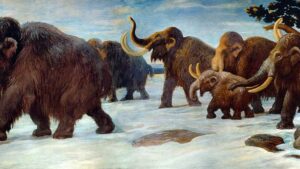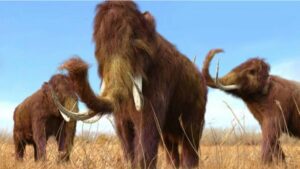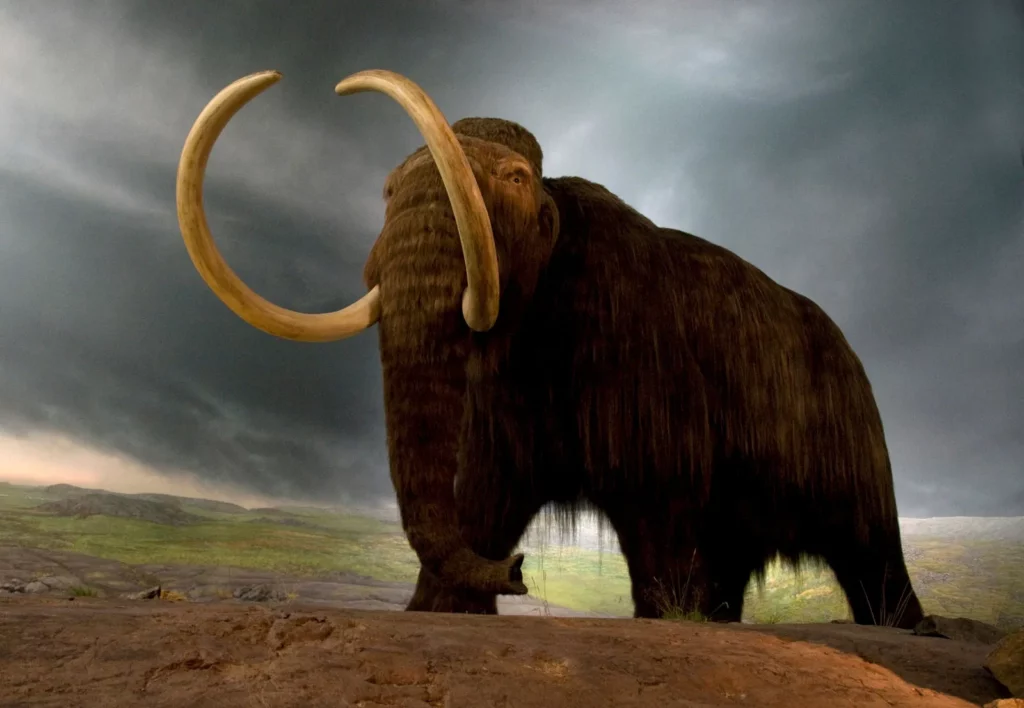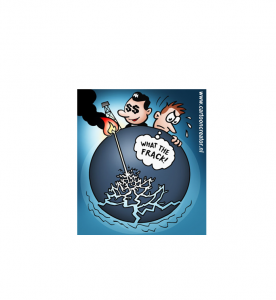Over time, there have been many species of both flora and fauna that have sadly gone extinct due to various circumstances, such as a drastic reductions in habitat or the inability to adapt to changing climactic conditions. While some of these species went extinct hundreds of thousands of years ago, many actually existed not too long ago. One of the most famous examples of an extinct creature is that of the Woolly Mammoth (Mammuthus primigenius), an elephant-like creature that lived in the time of the Ice Age, from around 300,000 years ago to around 10,000 years ago. This is a time when the global mean temperature was around 46F, which is about 11F colder than the modern global temperature. While that does not sound like a drastic temperature difference, it had a great affect on the earth as far as supporting cold-adapted habitats in greater abundance than what exists today. 1 These massive beasts were known to roam around the colder tundra-filled areas of what is now Europe, Asia, and even North America, regions that have been highly developed by humans. 2
The woolly mammoth is so well known that scientists are trying to reintroduce it back in the modern world, through the process of creating an embryo of a woolly mammoth, and placing in the embryo of the still living African Elephant. 3 A reintroduction returns an animal that has not existed in an area for a long time, be it extinct or still living today, back into its historic range. These kinds of things are usually done due to the fact that restoring an animal back into its native range would be an improvement for the ecosystem and the various species that may inhabit it. 4 This is something that has been done for many living species but has not really been done with animals that have been extinct for thousands of years. While this is a very interesting endeavor, should it be done? Based on the research that I have conducted, I would say no. Bringing the mammoth back is something that could have more consequences than benefits, and it may not even be plausible given the current environmental conditions of the modern planet.
Even though I believe that there is not a very good reason for the mammoth to be reintroduced, in the sense of taking an animal that has not existed on this planet for years and bringing it back in one form or another, there are many examples of reintroduction projects that have been successful at restoring the native ecosystems. Animals that have been reintroduced, such as gray wolves (Canis lupus) being brought back into the area of Yellowstone National Park to help with the overabundant elk populations, have had benefits that helped the ecosystem by restoring the native plant and animals that suffered in the absence of the wolf. 5 However, I do not think that the mammoth would be a similar success story. One reason I believe this potential reintroduction would fail is due to the lack of suitable habitat in the modern world that would be able to properly sustain it, in terms of land cover, area and temperature. Woolly Mammoths were large, hair-covered beasts that lived in a time when the Earth was much colder, with a lot of the area covered in snow and icy glaciers. Considering this, the mammoth was perfect for this type of environment. Its fluffy coat allowed it to keep warm in the frigid temperatures and the animal was adapted to be able to survive in the cold environment. 6

The problem with the mammoth being reintroduced to the modern world is partially due to the fact that the Earth is nowhere near as cold as it was during the Ice Age. If we look at the numbers that were mentioned in the first paragraph comparing the tempurature of the Ice Age compared to today, the global tempurature has change to such a high degree This global tempurature chage has occurred to such a high degree, in fact, that places where the mammoth may be able to survive if it was reintroduced are depleting rapidly. Places like this do still exist, yes, but they are growing smaller and more fragmented due to the warming of the Earth. Because of this, the mammoth would likely have a hard time finding a habitat with cold enough temperatures and suitable surroundings for it to be able to survive and thrive in the modern world. On top of this, the fluffy coat of the mammoth, meant to keep it warm in the much colder temperatures of the Ice Age, could cause a problem for it in much warmer climates. The coat could cause the mammoth to overheat, which in turn could cause serious heat related medical problems for the animals. Overall, these animals have characteristics that can make them unsuitable for the modern world. In terms of habitat, reintroducing mammoths may cause more problems then it would be able to possibly solve. For example, reintroducing a mammoth or another extinct animal into a habitat that it has not existed in for thousands of years could cause a disturbance in the ecosystem, and the mammoth could be seen as a man-made exotic species. Even if this was not the case, the plants and animals would have to adapt to a brand new animal suddenly being introduced into their habitat. 7
The problem of climate change does not only apply to extinct animals like the woolly mammoth that could be reintroduced in the future. In fact, climate change is already impacting animals that are currently reliant on colder temperatures that are having these habitats compromised and changed due to the effects of global climate change. A lot of animals live in much colder temperatures all over the world and have adapted to survive in the freezing temperatures. However, because of global climate change impacting the average temperature of the Earth, these habitats are in danger of disappearing in the coming years, due to melting and heating. As this happens, then these animals would not have a habitat to call home. Even worse, there is a very good chance they could die out as well, if they were not able to adapt to the environment or find another place to live that would be able to suit them. 8
Another issue with reintroducing the mammoth into the modern world is the fact that the food it relied on in the past may not be provided in the habitat of its native range. The mammoth, much like its modern cousin the elephant, was a herbivore, feeding only on plant life. When it was alive, despite it living in a very cold environment, the animal would have been able to come across enough plant life to be able to survive properly in the cold environment, despite its very large and bulking stature. It had no problem surviving back in the Ice Age, with an abundance of grass and other plant life that was able to sustain it. 9

Even in the modern colder regions, however, this is still a problem. In a lot of the areas that are still cold enough to support the Woolly mammoth, specifically in places where it used to live such as North America, there is very little plant life considering the cold temperatures that make it hard for plants to grow. As such, if the mammoth was reintroduced to these areas, then it would have a very hard time finding enough plants to be able to sustain itself, considering the large size of the creature and how much plant material it would need to eat to survive. If the mammoth was not able to find enough food to survive, it may move to warmer climates in search of sufficient food, where it would be difficult for a mammoth to survive and it would mostly likely die from starvation not long after it was reintroduced into the modern world. 10
Many species have gone extinct or had their populations reduced due to humans; food sources for wildlife may have disappeared due to climate change, they may have lost habitat due to human development, or been displaced by other species. Some of these more mobile species can travel to another area that has the food or habitat that they need to survive. Others, however, are not so lucky. They may not have another source of food to rely on, or may not be able to move to the food source. This would lead to starvation and the eventual extinction of the species. I believe this is something that could happen with the mammoth, as places where the creatures may be reintroduced may no longer be suitable, and it would be hard for mammoths to travel elsewhere to find food and be able to thrive. 11
The final reason that I believe that mammoths should not be brought back is less of a scientific reason, but more of an economic one. Nevertheless, I think it is something that should be taken into account. If we were to bring back woolly mammoths into modern society, this project would be extremely expensive. This is something that would cost millions if not billions of dollars in scientific research, along with the resources needed to be able to bring the animal back to life and hopefully keep it sustained. It would be something that would take a lot of time as well, as doing the research on how to actually bring the animal back would be extremely time consuming for the large group of scientists that would be involved. 12
In addition, the money that would be used for this project could end up just going to waste. As mentioned in the first two sections of this article, there are a lot of things that could go wrong in bringing back the mammoth. There are a lot of reasons that the mammoth may not be able to survive if it was reintroduced. If this is the case, none of the money that was spent on the endeavor could be brought back or returned. It would be pretty much lost with no sense of payoff whatsoever, other than lessons learned. This is another reason that it may not be a good idea to bring the mammoth back, as there is a large chance that it would ultimately be unsuccessful and the resources lost. 13

Instead of putting all of this money towards an animal that may not even be able to survive if reintroduced, I think that there is a much better and more logical solution. I think that instead, this money should go towards animals that already exist but are in the midst of becoming endangered or extinct. These animals already need our help if we want them to stay on the planet for years to come, and there could actually be a much bigger chance of helping them if the money was used on them instead of the mammoth. For example, we could use that money to help lessen the impact of global climate change on these animals, through educating people or supporting more sustainable energy alternatives. Furthermore, that money could be used in protection of the habitats that these animals live in, in the hope that we can sustain these habitats in a way that these animals would be able to survive better. This could include restoring degraded habitats or protecting natural areas from development. The mammoth itself is already long gone, but there are animals that are still alive that could surely benefit from this. Keeping them in this world may have more benefit as well, as they can help sustain the ecosystems that they live in and keep the Earth sustained for the future. 14
Overall, if the research on reintroducing the mammoth was strong, and scientists were able to find alternatives to the problems mentioned herein, the project could potentially work if humans were able to manage the population, in order to help sustain it in present-day conditions. However, the cons in my opinion seem to be too major for the mammoth to be brought back in a sustainable manner. Furthermore, there are better and more useful things that scientific research can positively impact instead of bringing back an animal that has been extinct for hundreds of thousands of years.
- Melissa Denchak, Are the Effects of Global Warming Really That Bad? (Consequences and Effects of Global Warming — What is the Impact?,2022) ↵
- M. Scott, What’s the Coldest Earths Ever Been? (NOAA Climate.gov, Feb 18 2021) ↵
- Tim Newcomb, Scientisits Are Reincarnating the Wooly Mammoth to Return in 4 Years (Popular Mechanics, 2023) ↵
- Species Reintroduction (Smithsonian’s National Zoo, 2021) ↵
- David G. Kleiman, “Reintroduction of Captive Mammals for Conservation” BioScience, vol. 39, no. 3, (March 1989), 152, 161 ↵
- Beth Alison Shapiro, How to Clone a Mammoth, the Science of De-Extinction (NJ, Princeton University Press, 2020), 197 ↵
- Beth Alison Shapiro, How to Clone a Mammoth, the Science of De-Extinction (NJ, Princeton University Press, 2020), 198 ↵
- Andres N. Molina, “Heat Tolerance of Marine Ectotherms in a Warming Antartica” Global Change Biology, vol. 29. no 1 (2022), 1 ↵
- Hope M. Babcock, ” The Genie is Out of the De-Extinction Bottle: A Problem in Risk Regulation and Regulatory Gaps” HeinOnline, no. 1 (2019), 178 ↵
- Hope M. Babcock, ” The Genie is Out of the De-Extinction Bottle: A Problem in Risk Regulation and Regulatory Gaps” HeinOnline, no. 1 (2019), 178 ↵
- Dinesh Bothra, “Lack of Food, Change in Weather Makes Vultures Leave Jodhpur”, Hindustan Times, (June 27, 2017) ↵
- Beth Alison Shapiro, How to Clone a Mammoth, the Science of De-Extinction (NJ, Princeton University Press, 2020), xi ↵
- Beth Alison Shapiro, How to Clone a Mammoth, the Science of De-Extinction (NJ, Princeton University Press, 2020), 195-196 ↵
- Beth Alison Shapiro, How to Clone a Mammoth, the Science of De-Extinction (NJ, Princeton University Press, 2020), 197 ↵


